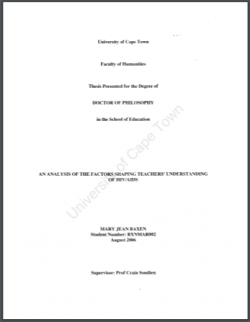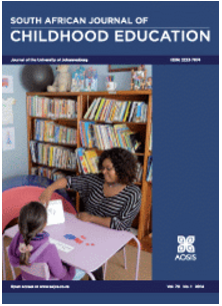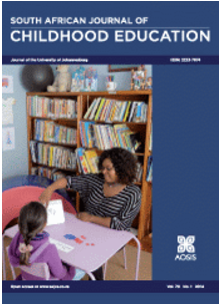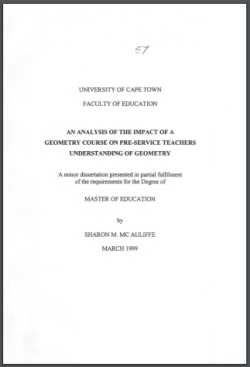Creativity or calamity : what does the future hold? : an examination of teacher's understandings of creativity in a sample of South African schools
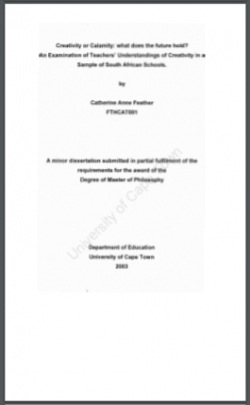
Type
Thesis
Authors
Category
ECCE, Foundation, Intermediate, Senior
[ Browse Items ]
Publication Year
2003
Publisher
University of Cape Town, School of Education, Cape Town, South Africa
URL
[ private ]
Pages
118 p.
Subject
Early childhood education, Primary education, Curriculum, Creativity, Teachers, Teachers' understanding, South Africa
Tags
Abstract
Technological progress, organisational change and intensified global competition have driven a shift from manual work to 'thinking' jobs that emphasise a whole new range of skills. It is no longer enough for students to show that they are capable of passing public examinations, for to thrive in an economy defined by the innovative application of knowledge they must be able to do more than absorb and feedback information. Learners and workers must draw on their entire spectrum of learning experiences and apply what they have learned in new and creative ways (Seltzer and Bentley 1999). To help equip our learners with the attitudes and abilities that will enable them to meet future problems creatively and inventively (Parnes 1970) we need a curriculum that acknowledges the importance of creativity, as well as teachers who are able to recognise and encourage creative behaviour in their classrooms. In the absence of any formal guidance in this regard, this thesis is an attempt to find out if teachers have the broad and accurate understanding of creativity necessary to do this successfully. To achieve this aim an open-ended questionnaire was compiled and distributed to a number of teachers in a range of teaching contexts. Responses were then analysed qualitatively using a method known as the Constant Comparative Method proposed by Glaser and Strauss (1976). An interactive model of creativity (and thus, one which took into consideration the creative product, the creative person, the creative process and the creative environment) was used to structure the questionnaire and to judge the responses. Using the literature as a yardstick it was determined that, at least on an individual basis, these teachers have an extremely narrow understanding of creativity. It was also evident that there were significant differences in understanding across contexts. This is an issue that needs to be addressed with some urgency if we intend to be at all successful in our attempts to educate for creativity in this country. A shared understanding of this term needs to be ensured - not assumed - something that could be achieved through the provision of a broad and inclusive set of guidelines.
Description
Thesis (MPhil)--University of Cape Town, 2003
Number of Copies
1
| Library | Accession No | Call No | Copy No | Edition | Location | Availability |
|---|---|---|---|---|---|---|
| Main | 911 | 1 | Yes |
